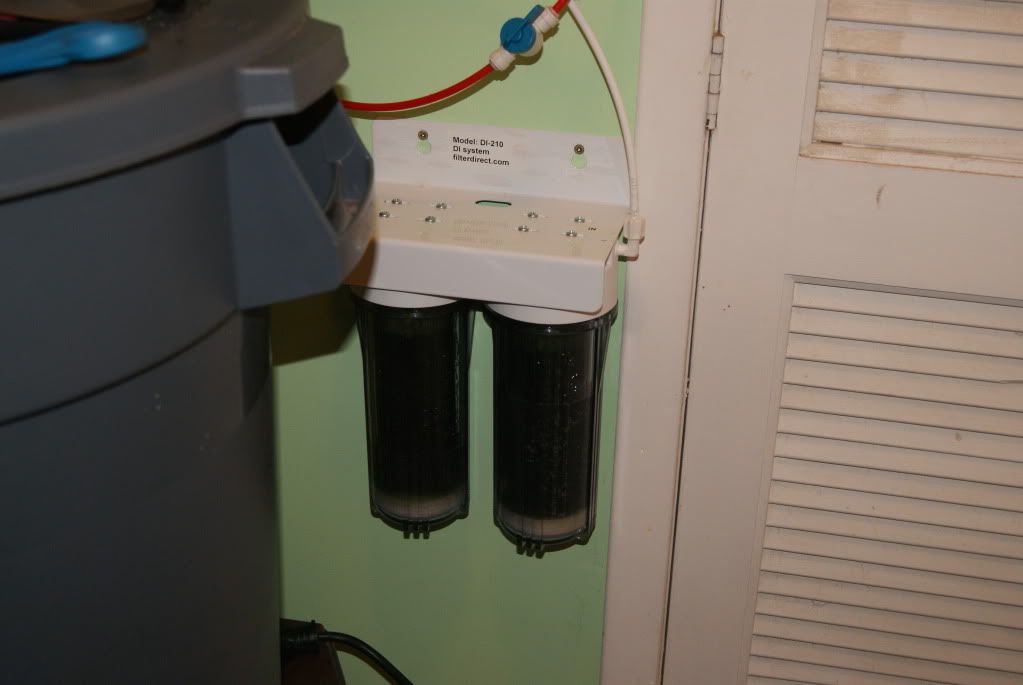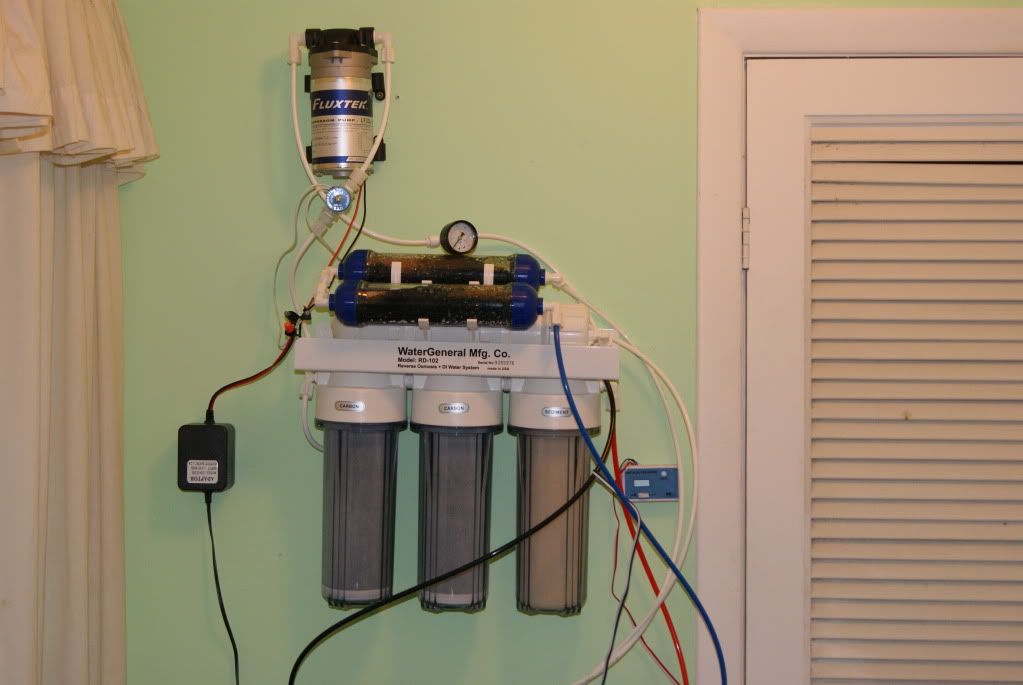well I honestly haven't looked into why tds is a ton higher for the first several min after pressuring up the system but I'm guessing it has to do with non ro blowing past the membrane until pressures on either side of the membrane hit an equillibrium. Higher/consistent water pressure, to a certain point, also tends to create cleaner ro water. You also see "tds creep" in ro systems when using a pressure tank beacause they make small amounts of water often, rather than large amounts all at once. When using di after ro you don't see this creep because the di eats it up. You could probably combine the right resins and not even use ro at all, but lord would it be spendy.
[Timezone Detection]
Create Account - Join in Seconds!
-
11-23-2011, 07:35 PM #11

-
11-23-2011, 07:45 PM #12

+1 on TDS Creep - TDS will be much higher for the first few minutes of starting the RO. Run the RO for a few minutes bypassing the DI. It's much more efficient to make water in larger quantities, rather then a few gallons at a time.
Increase feed Water Pressure - For reference, I have ~325 TDS well water. My BRS RO was creating 3 TDS water using house water pressure of 50~60 PSI. I installed a pressure pump and adjusted the input pressure to 90 PSI. This not only nearly doubled the volume of water made, but lowered the RO output water TDS to 1 (one) resulting in the DI resin lasting 3 times longer.Last edited by CalmSeasQuest; 11-23-2011 at 08:04 PM.
The reasonable man adapts himself to the world; the unreasonable one persists in trying to adapt the world to himself. Therefore, all progress depends on the unreasonable man. - George Bernard Shaw
-
11-24-2011, 01:47 AM #13

I was wondering how much water pressure you running into the membrane,I have found that since I imstalled a booster pump and started useing carbon block filters the di last much longer. The higher the water pressure into the membrane the better it will perform.It also helps greatly if you run your water to ro after the water softner if you haven't done so.. I also found useing a seperate final stage di helps with the tds creep if it's installed below the the containers inlet so that water must go uphill

seperate final stage di

booster pumpLast edited by binford4000; 11-24-2011 at 02:09 AM.
-
11-24-2011, 06:34 PM #14CR Member


- Join Date
- Jan 2011
- Location
- Warren
- Posts
- 133
- First Name
- Jeff R.Solution

i bought a booster pump prior to checking my current water pressure. i have city water and my pressure is already at 90, so i dont need the pump. but keeping higher pressures would increase the life of the ro membrane due to the fact that more can be forced through it. also over time the pores would clog up and the TDS going through it would decrease. so the older the membrane the longer that the DI resin will last, but the waste water would increase too.
i am still at a loss why the TDS reads high at first.... maybe the membrane is breaking down? bacteria that is eating at the material trapped in the membrane?[imglink]http://www.rowelab.com/AquaController/sig.php?n=flynnstone[/imglink]
-
11-24-2011, 08:21 PM #15
 TDS creep
TDS creep
"TDS creep, a phenomenon that occurs with all RO systems, causes a rise in product water TDS when RO systems are not in use. This rise in TDS occurs because concentrated water rests on the reject side of the membrane element while low mineral content water rests on the product water side of the membrane element. When no pressure is applied to the membrane element, these concentrations will slowly tend to reach equilibrium through the natural processes of diffusion and osmosis. As a result, rejection at system start-up is often less than the true capabilities of the RO system. A flush kit allows installers to lessen TDS creep, resulting in better quality water when the system is used after periods of inactivity." Taken from a flush kit sales memoranda online
 Tom Toro liked this post
Tom Toro liked this post
-
11-24-2011, 11:08 PM #16
 I need to attend a Fish Breeders Anonymous class.
I need to attend a Fish Breeders Anonymous class.
-
12-01-2011, 10:20 PM #17

TDS creep happens with all RO membranes and a flush kit is of no value for this other than to lighten your wallet. Think about it, the flush kit installs on the waste line and bypasses the flow restrictor so you temporarily increase the flow rate to waste.
The TDS creep water is on the TREATED side of the membrane already so you can flush all day on the waste side without affecting the treated side. Its a way to get in your pocket.
You said you have domestic well water so your problem is more than likely CO2 in the water which is tough on DI resin and cannot be measured as TDS so does not show up. Your membrane is doing a very good job in reducing the 375 or whatever it was TDS down to 4, thats almost 99% rejection rate which is much better than most systems are capable of.
Short of building a degassing station to reduce the TDS your best bet is to try Spectrapures custom blended DI resins, they are guaranteed to outperform any other resin on the market and they do work. My tap TDS is between 530 and 850 and we do have a CO2 problem here, with my old AWI Typhoon III system I could never get over 150 gallons of 0-1 TDS RO/DI water no matter which resin I used, what brand it was or how fresh it was. I fought this ofr about 5 years before purchasing a Spectrapure MaxCap system. My very first DI cartridge lasted 830 measured gallons right out of the box and the next was over 1000 gallons with no other changes.
They have tens of thousands of hours testing every resin on the market that has led to blending their own in-house so they can control its quality. Its as low as $18 a full 20 oz cartridge on sale and the SilicaBuster is probably what you need.
Untitled Document
If you have dual DI such as I do then the MaxCap/SilicaBuster combination is what I would suggest. There really is a difference. I tried straight from Resin Depot, AWI, PurelyH2o, Buckeye and many others and was even buying it in factory 50 lb sealed bags and boxes and vacuum sealing it for my friends in group buys. We all gave up and use only Spectrapure now.
TDS is not really as n=bad as it seems, its usually only a few ounces of water surrounding the membrane inside the housing and its no more than 1/2 the tap water TDS and usually much less than that. A few ounces is not going to kill a DI cartridge but it is a good idea to make water in larger less frequent batches so you get good long filter runs to flush the membrane well. If you make wate rnnually you can install a tee and ball valve between the RO membrane and the DI filter so you can open it and flush the first few ounces of treated RO water to waste so it does not get to the resin. Again this is treated wate ryou are flushing not waste like the fluh valve you see advertised do. Tom Toro liked this post
Tom Toro liked this post
-
12-02-2011, 05:29 PM #18
 240g Great Lakes Glass! ETSS1400/panworld250,LED 120wX4 AJM, LED,2x sunbrite ,Tunzex4/,200gal sump/mixed reef/Biopellets. Hammerhead return. UV 57w. Chiller.
240g Great Lakes Glass! ETSS1400/panworld250,LED 120wX4 AJM, LED,2x sunbrite ,Tunzex4/,200gal sump/mixed reef/Biopellets. Hammerhead return. UV 57w. Chiller.
135g down and given to a buddy. New pic after the wall is repaired.
Similar Topics
-
New to Reefing Water Changes
By Bella127 in forum BasicsReplies: 15Last Post: 05-23-2010, 06:46 AM -
Salt & Water RO / DI water?
By Woden in forum BasicsReplies: 3Last Post: 08-23-2005, 01:55 PM -
Salt & Water Test your "Water Change' water
By dakar in forum BasicsReplies: 0Last Post: 03-12-2005, 08:59 AM


 Reply With Quote
Reply With Quote




